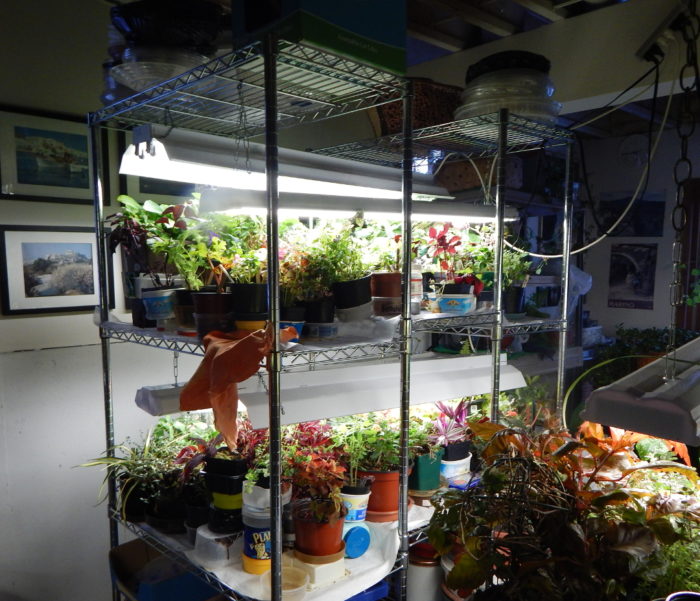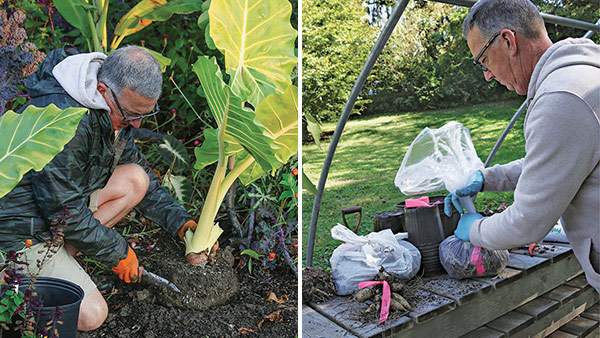
Arlene Lopas shared her beautiful garden with us some weeks ago and mentioned that she uses lights in her basement to overwinter many plants. Many of you were curious about the details of her technique, so today she’s back with some more images and all the information on how she makes her basement a safe haven for her many plants.

In the next several weeks, before the first frost can kill my annuals and tropical plants, I will be pruning (root, stem, and blossom as necessary), repotting, spraying with horticultural oil, and getting my basement “greenhouse” organized for the 23rd year. Why do I do this? For the challenge of keeping a lovely plant alive until next year that I may not see again in a nursery or garden center, to grow plants that would not normally grow in my zone, to save money (though my husband would say that is debatable), or just because I have the desire to collect plants that interest me. I bring about 200 plants of various sizes indoors in the fall.

The indoor setup I have consists of 10 standard 48-inch fluorescent shop lights, which will be on 16-hour timers, and 4 four-shelf metal storage racks on wheels (only two of the four shelves on the racks are used for plants; the other two shelves are used for storage of pots and other items). Each storage rack was fabricated from two standard sets of five-shelf units 36 inches wide by 70–72 inches high, and 18-inch shelves found at most home improvement centers. I use only four shelves for each set and tie the two units together using the remaining two shelves, in the middle, with the end product being 36 inches wide and 48 inches long. An old door with supporting sawhorses underneath serves as a table for larger plants.

Plastic racks with shelves are used for the two east-facing windows in the basement. Two small fans by this door prevent condensation. The furnace has an air-to-air heat exchanger, which helps control excess humidity, but more fans would be helpful. The basement temperature is 60°F. In the spring, I set up an additional fluorescent light to start my flower and vegetable seeds.

Every three days during the winter, I water the plants, check for pests, and prune and repot if necessary for about three to four hours. There is a lot of cleanup with falling leaves and pots that accidentally tip over.
Insects can be a problem, but I use insecticidal soap and horticultural oil indoors when necessary. Thrips, scale, and spider mites are the usual pests. Fungus gnats also can be a problem, so I’m careful not to overwater and let the top soil dry out on the plants that seem to have an infestation. Yes, some plants don’t make it, which is disappointing, but the vast majority do, and it is rewarding to see annuals blooming in January and February in the basement with the snow outside as a backdrop and then to watch them revive and thrive outside during the summer.

This indoor greenhouse wouldn’t have been possible without the help of two wonderful friends who have watched our house, our pets, and our plants for 23 years when we have gone on vacation. I’ve collected many of my plants on these vacations, and I have heard my husband say many times, “We just don’t have any more room in the car to bring back more plants.” Somehow, though, I have found a way.
Here are some of the plants I overwinter in the basement: lantanas, pentas, coleus, geraniums, ferns, ivies, jasmine, herbs, colocasias, alternantheras, begonias, strobilanthes, ruellia, asarinas, breynia disticha, acalpha, fuschias, succulents, small bougainvillea, and many others. I also have plants scattered throughout the rest of the house and may bring some downstairs when they need additional light or bring blooming plants upstairs so that I can enjoy them. (They go back under the lights when they are done blooming.)
My recommendations: Start small with the plants you want to keep for future seasons; realize the time and equipment commitment involved; utilize information from many helpful sources including magazines, books, the web, and your local horticultural agent or Master Gardener organization; and enjoy the lovely plants that you have helped survive another winter indoors.
I hope this information is helpful to other potential indoor gardeners.
Have a garden you’d like to share?
Have photos to share? We’d love to see your garden, a particular collection of plants you love, or a wonderful garden you had the chance to visit!
To submit, send 5-10 photos to [email protected] along with some information about the plants in the pictures and where you took the photos. We’d love to hear where you are located, how long you’ve been gardening, successes you are proud of, failures you learned from, hopes for the future, favorite plants, or funny stories from your garden.
If you want to send photos in separate emails to the GPOD email box that is just fine.
Have a mobile phone? Tag your photos on Facebook, Instagram or Twitter with #FineGardening!
You don’t have to be a professional garden photographer – check out our garden photography tips!
Do you receive the GPOD by email yet? Sign up here.
Fine Gardening Recommended Products

Pruning Simplified: A Step-by-Step Guide to 50 Popular Trees and Shrubs
Fine Gardening receives a commission for items purchased through links on this site, including Amazon Associates and other affiliate advertising programs.

Spear & Jackson 4930FZ Razorsharp Telescopic Tree Pruner
Fine Gardening receives a commission for items purchased through links on this site, including Amazon Associates and other affiliate advertising programs.

















Comments
Wow! You certainly have that going. Wish I had a basement to do that in
What an interesting and helpful post! You should write an article for the print edition, and Fine Gardening should print it! Question: as the florescent light tubes die, how do you replace them? New ones I have bought are LED, and I am not sure that they emit the light plants need. I only use lights for seedlings, and found it hard to replace lights I had lost.
LEDs are fantastic for growing, especially so when you get the full spectrum lights. The big benefit is that they don't throw a lot of heat or take a lot of energy to run, which used to be a problem.
Thank you, Arlene, for so generously explaining your approach to overwintering so many of your plant treasures. I enjoyed a smile at your husband's teasing questioning about whether your heroic efforts are "money saving"...but, hey, if the activity keeps you happy and energized, it is a bargain. Your physical set up and commitment to proper care giving is very impressive. Ha, the famous last line of a Rudyard Kipling poem sprang to mind... “You're a better man than I am, Gunga Din.”
Thanks to Arlene for sharing her success!
I would say most orchid growers in temperate climates grow under lights. Hobbyists have many methods of making it work. I remember one gentleman that went to Florida every winter, and left his orchid collection down his basement, under lights, with misters running on timers. :-) Crazy!
Log in or create an account to post a comment.
Sign up Log in